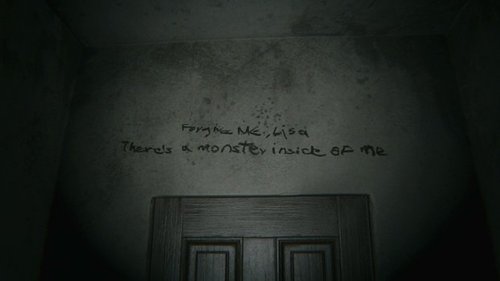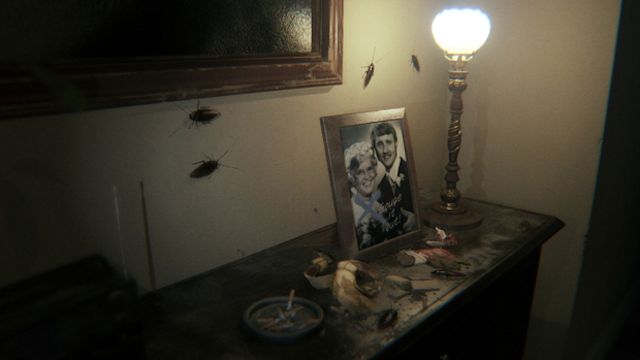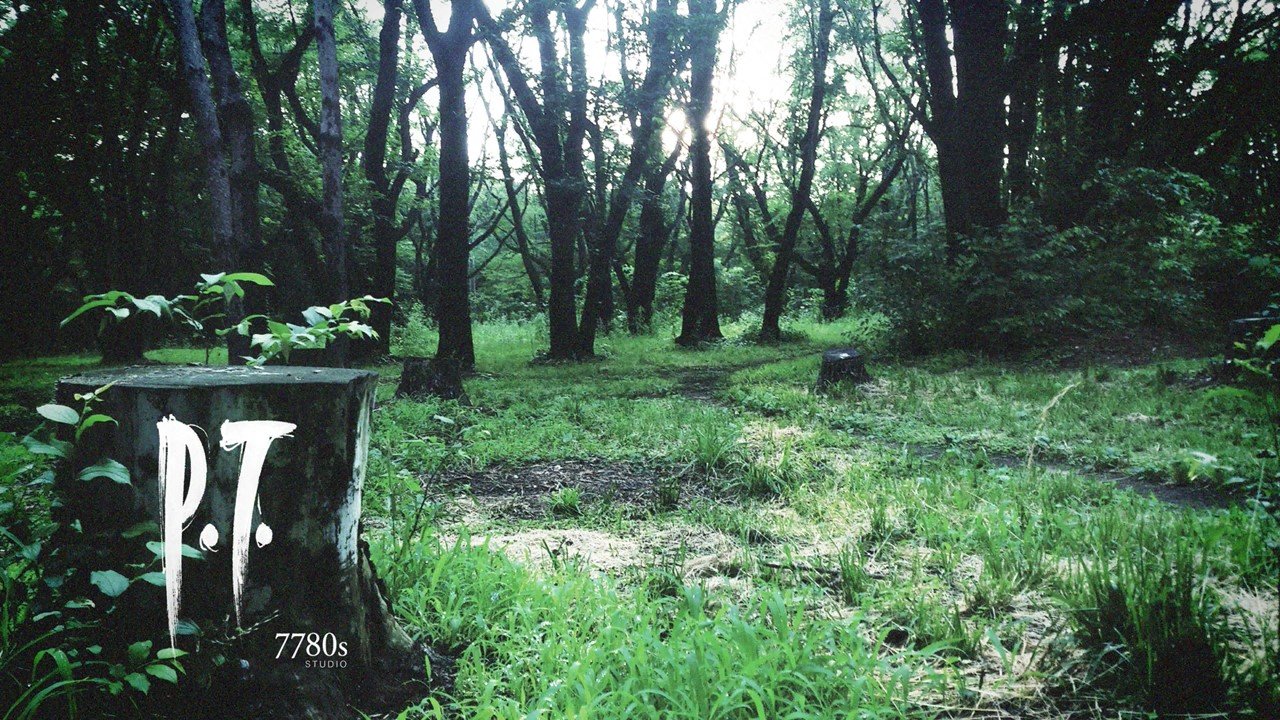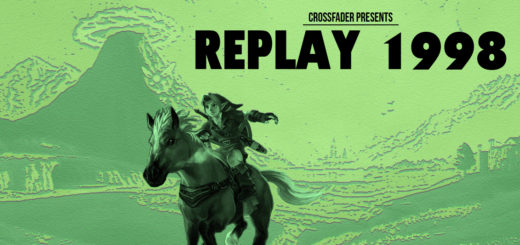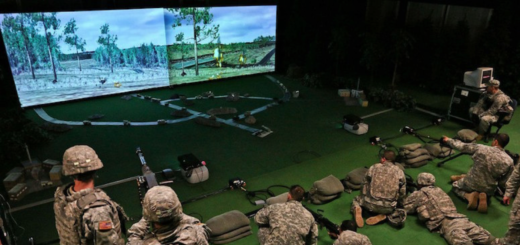How A Teaser Saved Horror: A P.T. Retrospective
On the 12th of August, 2014, I awoke in a dilapidated cement room. Two cockroaches joined at their backend crawled past me. I stood up to notice that the walls had thousands of tallies etched into them. How long had I been here? I heard new tallies being etched into the walls, but I could swear I was in the room alone. I proceeded through a wooden door and entered a cozy suburban home. Dead quiet, save for radio blaring information about a string of small-town murders. I continued down an L-shaped corridor and walked through the door at the end of the hall in hopes of finding an exit. But once I stepped through, I was right back at the start of the hallway. This was my first time playing P.T.
P.T (short for Playable Teaser) was released on the PlayStation store as a free-to-download experience. Its unannounced appearance on the store only furthered the enigma surrounding its existence. Only once players had completed the game, and word of mouth circulated through the web, did it become public knowledge that this was an interactive teaser trailer for Hideo Kojima and Guillermo Del Toro’s partnership on the latest Silent Hill installment, SILENT HILLS. Kojima, a developer notorious for wanting to design and implement cryptic puzzles, fourth wall breaks, and holistic game design into his titles, had finally been granted his wish with P.T. After all, he couldn’t frustrate gamers that purchased his game, because the experience cost them nothing but time.
“As a teen in Kawanishi in western Japan, Kojima’s obsessions were movies, Japanese manga comics, and novels,” an education that allowed for his game design to be markedly more cinematic than his contemporaries. As such, P.T’s greatest contribution to its medium is perhaps that it recognized that there is more to game design than providing a sense of gratification to its player, channeling the human psyche’s understanding of interactivity and previously uncharted emotions of hopelessness and the mundane.
Sadly, after months of hype for the release of the final game, developer Konami announced their bitter breakup with Kojima, resulting in the sudden cancelation of SILENT HILLS and the removal of P.T from the PlayStation store, causing the games to be destined for lives of obscurity. Now that P.T is no longer readily available, I think it’s fair to deconstruct it, because although the following paragraphs may lessen the depth of the experience compared to going in blind, I think it’s vital that P.T gets analyzed fairly as one of the most visceral, emotionally complex releases in contemporary media.
Naturally, I must give credit where credit is due and acknowledge that, in some ways, Frictional Games initiated the new renaissance of horror gaming through their games PENUMBRA, AMNESIA and SOMA. However, it is undeniable that Frictional Games are an anomaly among an onslaught of B-rate, cheap thrill copycats. It’s not really to anyone’s surprise that the first SILENT HILL and RESIDENT EVIL installments are the benchmarks of video game horror, and later on DIABLO II in 2000, with add-ons and boosts to the game available from d2boost to accentuate the horror and dark fantasy a bit more. Unfortunately, they’re also remnants of yesteryear that no one seemed to be able to recreate. Oddly enough, it seems that the horror game dry spell came to a close in the last few years through independent developers who capitalized on the untapped market and unleashed such a whirlwind of content that today it almost feels oversaturated. That’s a tip for current game designers, make sure the genre you’re targeting isn’t oversaturated but there is still interest in it. Then all you need to do is nail the visuals, get your hands on some free video game music to save money and create hype around your game. The horror genre just wasn’t as exciting as it once was.
That’s not to say there haven’t been absolute gems along the way. CLOCKTOWER, ETERNAL DARKNESS, CONDEMNED and FATAL FRAME come to mind as clear highlights, but the vast majority of modern horror gaming was reduced to action shooters with horror quirks, best seen in F.E.A.R., PREY, and DEAD SPACE. These games aren’t inherently bad; in fact, they’re still probably objectively better video games than some of the jump-scare laden releases served over Steam (the world’s largest digital game distributor) these days. What’s troublesome is that the absence of horror games that dare to challenge us as thinkers has left the impression on developers that there isn’t a fan base eagerly awaiting such a game.
For the longest time our gaming emotions were relegated to satisfaction, comfort, happiness or frustration and anger, depending on whether you would beat a level, further an on-screen relationship, reach a high score, die in a match or lose a race, respectively. As such, emotions attributed to gaming have always been rather surface level, never digging any deeper into complex responses that allow the player to truly feel conflicted about the interactivity of the medium. In the late 2000’s, developers tampered with more complex narratives, trying to channel cinematic storylines and characters.
With the wave of choice-based gaming ushered in by Telltale Games and Quantic Dream, players were allowed to interact in what could best be described as playable films, best seen in THE WALKING DEAD GAME, HEAVY RAIN, UNTIL DAWN, LIFE IS STRANGE and so on. However, when all is said and done, the problem with choice-based gaming is that the mechanics are fairly rudimentary: players choose to say or do something good or bad, sometimes these choices are not so obvious, but in the end your feelings towards what you are doing are always presented to you on a silver platter, and within a choose-your-own-adventure style cinematic cutscene.
Naughty Dog’s THE LAST OF US, Irrational Games’ BIOSHOCK and 2K Games’ SPEC OPS: THE LINE managed to integrate the concept of complex emotional responses with less flagrant choice-based mechanics. In each game, players are lead to believe that their actions are for the greater good, only to discover that their motivations were either in self-interest or manipulated by an antagonist. In doing so, these developers capitalized on a unique facet of progressive game design: in order to integrate new, more ethically complex narratives, the game must subvert the genre expectations set by its predecessors, otherwise it will constantly be stuck in the rut of black and white depictions of right-and-wrong. While P.T isn’t a fight between good and evil, it channels feelings that have otherwise been absent in gaming, notably the emotional response of desperation and paranoia, turbulently throwing its player down a rabbit-hole that has no end.
Stepping into the shoes of a man who is trapped in some sort of purgatory, P.T never completely explains its plot or characters, but rather implies information that the player has to observe and comprehend by carefully examining the environment. While this might not sound particularly innovative to a common gamer, it represents a modernist shift in independent gaming that triple-A titles have mostly avoided: the eradication of the in-game cutscene. The best way to explain this is to look at game developer Terrence Lee’s academic analysis of game design, DESIGNING GAME NARRATIVE:
“[Silent films] have pretty good cinematography and very good acting. You could say that they fill out the visual experience quite well. However, every once in a while, an intertitle comes up. Intertitles are those fullscreen captions that describe what is happening or contain dialogue. During these captions, the film regresses back a dimension – it ignores the sensory experience, the thing that makes film unique from literature, and puts straight up literature on the screen. Over the length of the film, it generally maintains high levels of visual experience; however, whenever an intertitle comes up, the amount of sensory experience drops down to near zero. The exact same thing happens with game cutscenes.”
In the same way that the advent of sound allowed filmmaking to become its own, wholly unique art form, games like P.T transcend gaming’s reliance on filmic structure for story progression. As such, one could argue that P.T and its peers are slowly pulling gaming out of its silent era. Through in-game radio transmissions and various other pieces of exposition, we learn that our playable character is probably the wandering spirit of a man who has killed his wife and child, and is now being haunted inside of his home by their ghosts. Unlike a traditional game, all this information is relayed within an interactive environment that will divulge intelligence whether or not you are present to hear it. Thus, cutscenes are never there to put straight up film on the game screen, embracing the medium of gaming. These ideas were certainly tested in games released years prior to P.T, but Kojima refined the execution through the containment of his setting.
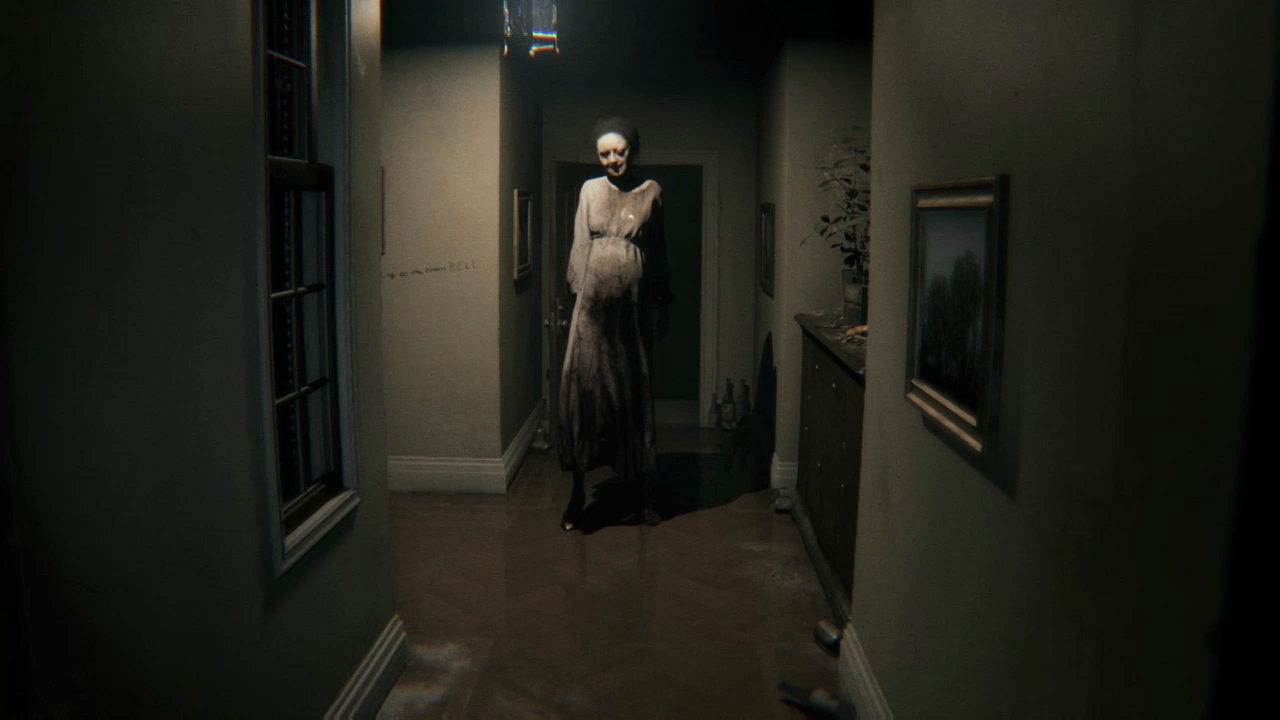
Richard Rouse III explains this in his essay found in HORROR VIDEO GAMES: ESSAYS ON THE FUSION OF FEAR AND PLAY on the creation of his game THE SUFFERING:
“We buried a lot of our back-story in subtle storytelling sections involving dialog played over gameplay, graffiti written on walls, very quick semi-animated flashbacks, and cryptic journal entries the player could unlock. This enabled us to keep the story mysterious enough that the player would still be left with numerous unanswered questions. My hope was that the player would fill in the blanks with his own imagination. […] minimalist game storytelling fits perfectly in the horror genre.”
Kojima mentioned in an interview that “For P.T I decided against using a ruin as the stage and had it take place instead in a simple hallway. That way, I didn’t have to worry about the cultural background of the player. I wanted people to experience the fear of not being able to escape in a world where there was almost no information on the screen.” When creating the game, Kojima refrained from using graphic violence to build up suspense, as he felt that too many horror games relied on the trope. Instead, he opted for a more “genuine, thoughtful and permeating” fear. Rouse reaffirmed this theory in his essay by explaining that “horror stories are typically set in highly recognizable locations that the player can identify but which have been invaded by some evil force. This force has often altered the rules of the world in some way.” Where most developers would use this formula to justify cause for action, running and violence (and thus entertainment via action-based gratification), Kojima flipped the tables, opting for slow-burn repetition in order to evoke a nauseating sense of desperation.
One striking commonality most current horror games share, whether it be ALIEN: ISOLATION or SLENDER, is the run-and-hide mechanic. This design turns every level into some form of reaction-based sport, taking the player out of the narrative and into the realm of traditional gaming. This is often assisted by a HUD (heads up display) that usually provides vital information like health, ammunition, and a mini-map. Lately the HUD has been stripped from horror games for further immersion, but P.T took this a step further, removing the “travel from A to B” mechanics in favor of a growing sense of confusion and unease. For all intensive purposes, you have quite literally stepped into the POV of this character. Furthermore, you are restricted to a walking pace and health, directional cues, hiding or fighting back are not mechanical functions.
P.T never relies on bland travel, but rather a commitment to the mundane. Kojima fools the player into believing that nothing can hurt the playable character, because the hauntings don’t become aggressive until late into the game, and even once they do, they don’t do anything but send you back to the start of the hallway, functioning as a mere stress mechanic. In contrast, other horror games establish danger almost immediately, taking away the curiosity that the game’s first act can evoke in the player. This works doubly in P.T’s favor when considering that it came out without anybody knowing what it even was, allowing for the horror to reveal itself as a sharp left turn in the midst of an initially disquieting, but not intrinsically terrifying experience.
Most games have you attempt to navigate your way out of asylums, haunted homes, alien infested spaceships, and dense forests; P.T never gives you that light at the end of the tunnel. This cruel mechanic withholds hope from the gamer, causing P.T to function like an inverted horror game. While many games throw hope out the window in the inciting incident (the opening of THE EVIL WITHIN is a great example) and only gradually reveal that there is in fact a way out, P.T is a downward spiral into an imminent pit of despair, where the regularity of its setting turns into a haunting sense of routine.
“Although it’s acceptable to shock the player within the context of the game, it’s not desirable for the player to be shocked by something in the meta-level of the game, for instance, by discovering only too late that there is no way back to an earlier area.” (Chris Mark Bateman)
Kojima disagrees with this statement, keeping his player on their feet at all times. This approach is demonstrated in many of his titles, but P.T represents a duality where the looping corridor implies that there is always a way back to an earlier area, although the player never knows what might be different this time around.
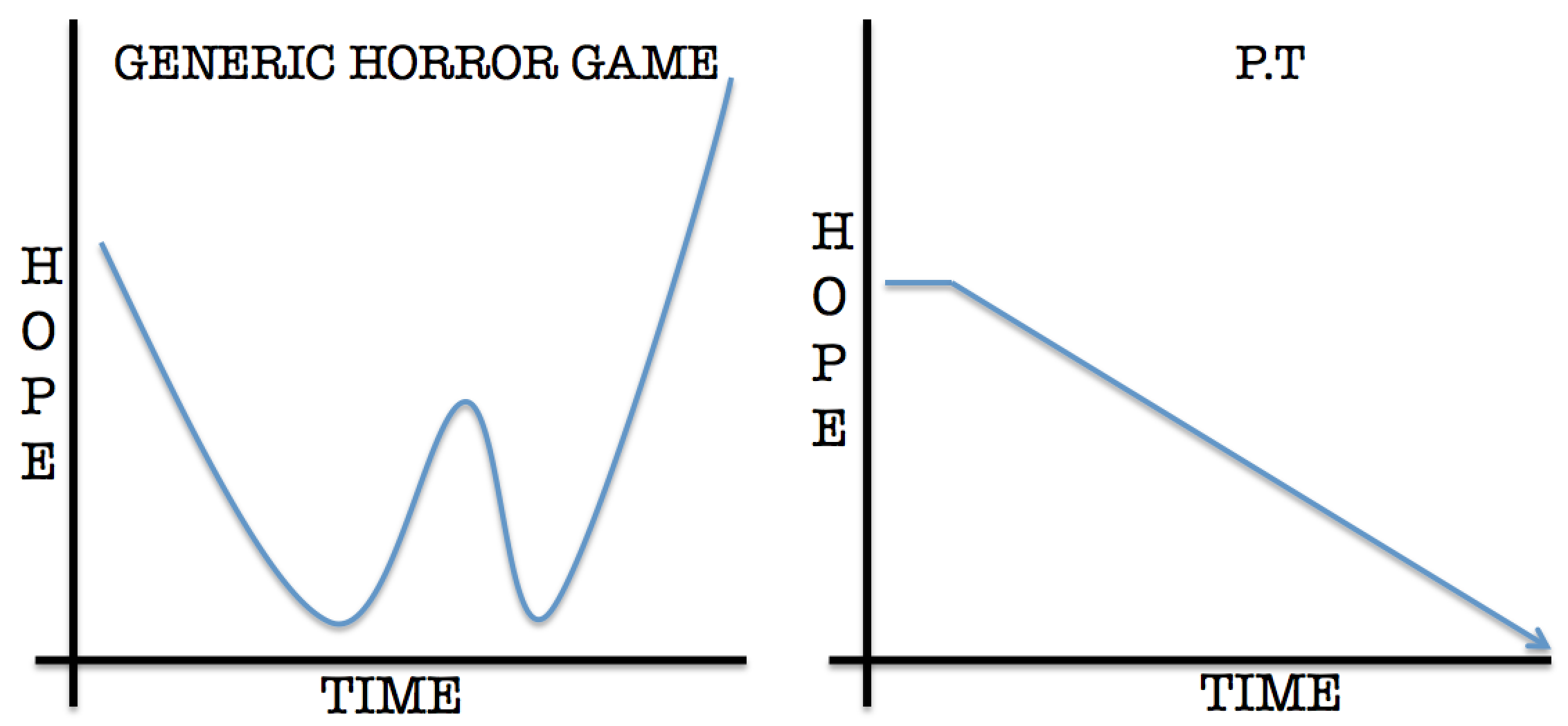
Almost every horror game pits its protagonist against overwhelming odds, but in P.T the odds are never really even established. AMNESIA: THE DARK DESCENT has its monsters, but you’re not allowed to look at them. FIVE NIGHTS AT FREDDY’S has killer teddy bears, so you better barricade yourself in when they’re nearby. P.T has Lisa, and there’s nothing you can do about her. The fact that Lisa melts into the setting is also the game’s strongest asset, because she never feels like an entity that can be interacted with, thus she is never there and always there at the same time, amplifying the terror. When considering the implications of P.T’s first-person perspective, an obvious detour from SILENT HILL’s trademark third-person aesthetic, one can only conclude that if you can’t see Lisa, it’s because she’s always behind you. This theory is validated when one notices that Lisa’s shadow is actually locked to the player-character, as well as when she appears behind you in the mirror reflection during the final hauntings. In a video essay analyzing the merits of P.T’s game design, YouTuber and games journalist George Weidman states that:
“[it’s important that Lisa’s shadow is locked to your back because] this house is designed to keep your backside always vulnerable to her. Lisa’s ghost [when seen at all] can be sighted by the first door, by the loop door, by the window, in the bathroom mirror, on the bathroom floor, upstairs, or just below upstairs, so no matter where you’re looking, you’re always turning your back to one of her entry points.”
The in-game radio transmissions are also handled with Kojima’s signature Japanese knack for the uncanny, and continue to refer to Lisa’s looming danger by exclaiming, “look behind you” during portions of the announcement. While the home itself isn’t visually off-putting, the absence of detail in wall paintings is peculiar, and the radio announcer makes statements in his transmissions that are notably uncharacteristic of an American setting. While reporting on the string of murders, the radio tactlessly states “don’t touch that dial, we’re just getting started” and follows with “police arrived on scene after neighbors called nine-eleven”. As such “there are enough things just off in a familiar setting to make the package seem much more surreal.”
Furthermore, the game makes a clear meta statement within its opening phrase: “The only me is me, are you sure the only you is you?” Kojima slyly winks at his audience, letting us know that of course Lisa is Lisa. Nobody else is in charge of her. But who are you? Who is the player-character, and to what extent are his actions a result of his own free will? Because at the end of the day, it’s the gamer himself who is to blame for all of this, harkening back to the wall etching that declares, “Forgive me Lisa, there is a monster inside of me,” the monster being the gamer himself, and the message having been written by a distraught protagonist who has been possessed by you, the player. Kojima hereby makes a bold commentary on the nature of player choice versus character perception.
This is henceforth validated by the paper bag in the first room, which speaks to you, exclaiming, “I walked. I could do nothing but walk. And then, I saw me walking in front of myself”. It’s possible that this directly correlates to the possession of a man who had no control when murdering his family, but it’s indisputably a greater statement about the psychology of horror gaming, creating protagonists with whom we empathize, yet never leaving them in control of their fate, possessed by the gamers who tell them whom to kill and how. It’s undoubtedly the best piece of meta commentary since BIOSHOCK: INFINITE’s critique “on the problematic nature of video game storytelling.”
Well aware that it’s extremely short and brutally challenging to solve without the help of forum threads, P.T loves to torment its player through impeccable sound design and an attention to the minutiae of what can be heard in a room, allowing the viewer to make new visual and auditory discoveries with every playthrough. The game rewards you for taking your time, but these rewards don’t come as power-ups or new character skins, but rather a raw, satisfying immersion into a setting. As such, any quality that would make P.T a video game that you might play for fun, escapism or entertainment is mostly eradicated, because it’s fundamentally more unnerving than entertaining. Kojima has no time to waste satisfying your carnal desires as a gamer, instead wanting to direct the medium of interactive gaming closer towards interactive cinema without stooping to becoming a Telltale Games copycat. P.T’s greatest proclamation is that cinematic video games don’t have to be films with QuickTime Events and dialogue cues, but rather games that don’t even go near the formula we have come to understand as traditional gaming.
Kojima also makes sure to leave no stone unturned in how P.T subconsciously manifests before being booted up. Let’s take the cover of the game as a case in study:
Most people probably don’t even pay all too much attention to it, especially because hard copies of the game were never made. But when looking at this image, it’s fascinating to note that the cover is of a forest, not the L-shaped corridor that the entire game takes place in, not Lisa, nor the town of Silent Hill. While most people would shrug this off as a pretty piece of art that serves to be ambiguous in its connection to the SILENT HILL franchise, I think it’s worth mentioning that most gamers surely start this game with the anticipation that soon they will be leaving this house in order to explore the forest that’s on the cover. The game never implies that you will ever be leaving the house, and of course you never do, but the fact that this expectation has been created by the gamer alone only furthers their desperation once the hauntings start to take their toll.
P.T is a horror game that allows the gamer to create exposition for themselves, reinventing how to relay information. I recently introduced a new friend of mine to the game (which I thankfully still have on my PS4 hard drive) and he yelled “I don’t have a weapon!” after his first Lisa sighting, promptly following that statement by mentioning he couldn’t even outrun her if he wanted to, since the protagonist can only walk. The brilliance in design is that P.T never informs you of directions, abilities or goals through text-based information, and capitalizes on your expectations as a gamer to propel its mechanical subversions.
“Generally speaking, when the player hits the limits of the game world, it is sufficient for a line of dialogue from an appropriate character to indicate that the player either cannot or should not continue. Because the game will not physically let the player travel any further, they have no choice but to accept this situation.” (Chris Mark Bateman)
Kojima evades the necessity for this entirely in P.T due to the endlessly looping corridors. With the advent of postmodern game design it’s become a priority for game developers to narratively rationalize your abilities and the world around you. As such, games like ZOMBIIU, SPELUNKY or BIOSHOCK are prime examples of how character death is more than just pressing the “rewind button”, either putting you into the shoes of a different character each time or using multiverse theory to justify your sudden resurrection.
It’s certainly worth noting that this exceptional fan-made short film does an incredible job at copying the aesthetic structure of P.T on a beat-for-beat level. However, what the video never channels is the hopelessness of the player. Cinema’s most unique quality is that the viewer is along for the ride and has to accept those circumstances. P.T toys with the notion of interactivity, only to teach its player that the gamer is in no way in control of their fate. With this growing realization, the controller begins to lose value. The 15 buttons, two analogue sticks and touchpad of the PlayStation’s controller suddenly have no purpose, because all the player can do is walk and accept that Kojima has taken the reigns.
In a gaming climate where players are continually told that they are at least tangentially in charge of their characters destiny, Kojima dared to do the opposite. To a degree, every gamer suffers from a God complex. Whether we’re building entire civilizations in SIM CITY or going on a road-rage in GRAND THEFT AUTO, gaming relies on our desire to control the impossible by stepping into the shoes of a virtual superhuman. Kojima shatters this God complex, forcing his player to accept the fate that he has in store for them. By playing into genre tropes, P.T capitalized on the mundane, forcing gamers to play as a person even less powerful than themselves, and subverting one’s understanding of interactivity by reducing player abilities to nothing more than deciding where to stare. Suddenly, gamers weren’t playing something fun, but something hopeless.
Opting for a permeating sense of dread over gore and violence, essentially reinventing what it means to not just play a horror game, but a video game entirely, P.T is a milestone in design. The most essential takeaway from Kojima’s teaser is that games have the ability to channel emotional responses that go far beyond the sports-based reactions of satisfaction and frustration (winning and losing) that have long been relegated to gaming. The ability to make a player enter a pit of despair signals a pivotal turning point for video game design and the medium’s unique ability to toy with a players understanding of on-screen violence and how they cope with responsibility once they begin to make sense of the fallout of their actions.

